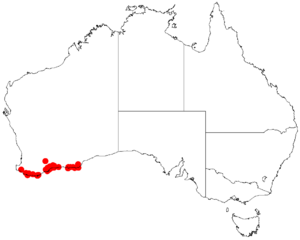Acacia crassiuscula facts for kids
Quick facts for kids Acacia crassiuscula |
|
|---|---|
| Scientific classification | |
| Genus: |
Acacia
|
| Species: |
crassiuscula
|
 |
|
| Occurrence data from AVH | |
The Acacia crassiuscula is a type of shrub that belongs to the Acacia family. You can find it growing along the south coast of Western Australia. It's a special plant that's part of Australia's amazing natural world.
What it Looks Like
This shrub usually grows straight up and can be anywhere from 1 to 2.5 meters (about 3 to 8 feet) tall. Its small branches are smooth, without any hairs. The leaves, which are actually flattened leaf stems called phyllodes, are dark green and grow upwards. They are long and narrow, about 5 to 10 centimeters (2 to 4 inches) long and 1 to 4 millimeters (less than an inch) wide.
The Acacia crassiuscula blooms with pretty cream-yellow flowers from July to October. These flowers grow in groups called Inflorescences, which are arranged along a stem called a raceme. Each raceme can be 1 to 6 centimeters (about 0.4 to 2.4 inches) long and has three to eight flower heads. Each flower head is round, about 5.5 to 6 millimeters (0.2 to 0.24 inches) across, and holds 13 to 20 cream-colored flowers.
After the flowers, the plant forms seed pods. These pods are long and narrow, with pinches between each seed. They are about 10 centimeters (4 inches) long and 4 to 5 millimeters (0.16 to 0.2 inches) wide. Inside, you'll find shiny black seeds that are shaped like ovals, each about 4.5 to 4.8 millimeters (0.18 to 0.19 inches) long.
How it's Named
This plant was first officially described by a botanist named Heinrich Wendland in 1820. He wrote about it in his work called Commentatio de Acaciis aphyllis. Later, in 2003, another botanist, Leslie Pedley, changed its name to Racosperma crassiusculum. But then, in 2006, it was changed back to its original Acacia name.
Sometimes, plants can have more than one name, like nicknames. For Acacia crassiuscula, some other names it has been called include Acacia pycnophylla and Acacia sieberi.
This Acacia crassiuscula looks quite similar to two other Acacia plants: Acacia cupularis and Acacia harveyi. Its leaf-like phyllodes are also the same shape and size as those of Acacia euthyphylla.
Where it Grows
The Acacia crassiuscula is found naturally along the southern coast of Western Australia. It grows in areas like the Goldfields-Esperance, Great Southern, and South West regions.
You'll often spot it near granite rocks and on hills. It also likes sandy areas or rocky soils, especially if they are on top of granite or quartzite rock. Most of these plants grow between the town of Albany and Cape Arid National Park. There are also some smaller groups of them scattered in other places. This plant is often part of the low, dense bushland called mallee scrub and heath communities.

